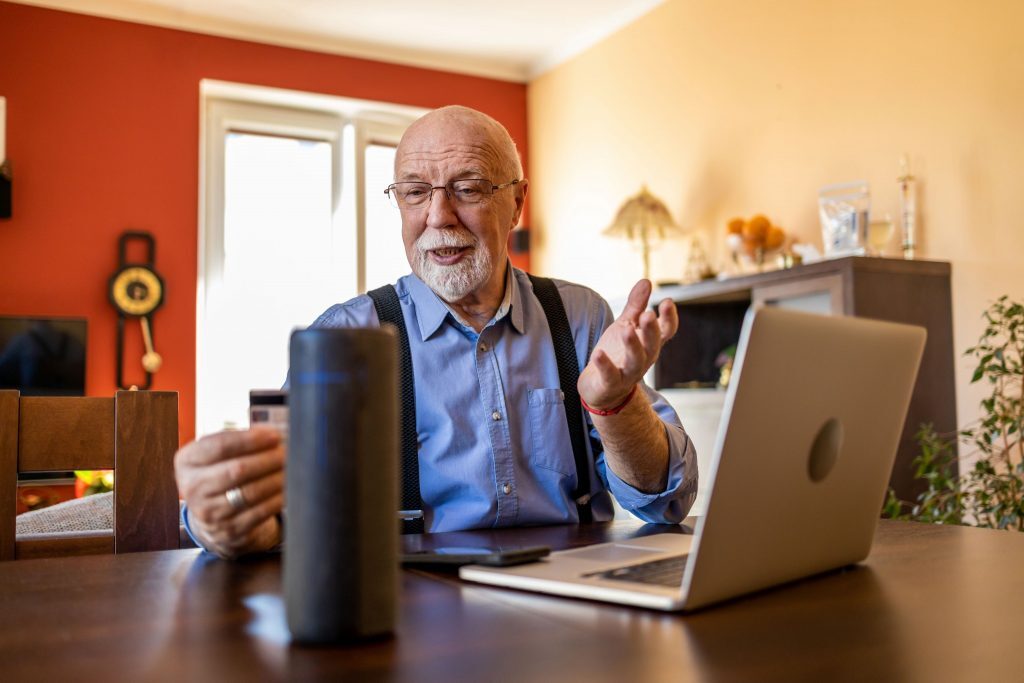
Voice Commerce is an AI-powered technology that allows you to use your voice and a smart device (for example a phone or a digital assistant) to search for, inquire, and purchase products online.
WHAT ARE THE BENEFITS OF VOICE-ASSISTED SHOPPING?
For consumers…
It’s convenient.
It saves time. (Voice ordering averagely takes less than a minute.)
It can save money. (Asking your digital assistant to find deals, coupons, and promo codes is much easier than doing it yourself.)
It’s a tremendous hands-free, multi-tasker.
It’s personalized. Data-at-the-ready makes it easy for the system to understand your purchase preferences.
Great for impulse buyers, shopping lists, last-minute items, reminders (when you’re in the car, at the park, etc.)
For businesses….
It increases orders.
If can increase AOV (Average Order Value.) This may take work, but it’s likely to happen.
It can increase AAUS (Active Average User Session) and the number of Pages Viewed. Depending on how you’ve set your Voice-Assisted Shopping Program up, it can also dramatically decrease them. (Remember, some Voice transactions are completed without any screens whatsoever. However, the majority still use screens at some point in the process, whether it’s a digital assistant screen, phone screen, watch screen, or even a desktop screen.)
It’s faster. Speaking reduces TTT (Time to Transaction) as most people speak faster than they type. One of the reasons why all kinds of companies are investing in Voice Commerce is because they know they can save people time by reducing their transaction times, and even better, they can actively help/push users to success if they stumble along the way. (Imagine an angel on the shoulder of everyone who books a flight online or tries to buy tickets on Ticketmaster.)
It reduces friction. Voice-Assisted Commerce is being touted as “frictionless.” It definitely has fewer friction points, but it’s not entirely free of all hurdles yet. (Think: all those nasty distractions that happen around you, especially when people can’t “see” that you’re talking to someone.)
WHAT ARE SOME OF THE BIGGEST DRAWBACKS OF VOICE-ASSISTED COMMERCE?
For businesses….
Costs and commissions.
Adoption. It’s still new and unfamiliar to many people, so trust levels vary within demographics, psychographics, and persona levels.
Data ownership is tricky. Whatever platform you use (Alexa, Google, Siri, etc.) will know what your customers are inquiring about and buying. Pundits who dismiss this as a drawback underestimate the power of the big players, especially Amazon.
Privacy concerns. It’s fair to say that this is one of the biggest things holding Voice back. Will it be solved? Yes. It’s just taking longer than folks expected.
For consumers….
Voice, in general, is still young, so there are kinks. Things are getting better, but it’s nowhere close to perfect, so users often need to exercise patience when conversing with their digital assistant. That can be tricky for some user groups as they primarily use Voice “to speed things up.”
Other challenges: getting a good result is difficult when you ask a multi-part question. It can also be tricky for the Digital Assistant to respond correctly when there’s a lot of background noise, or multiple people are trying to talk to it at once, which happens a lot in families.
It can be hard to find things, especially new products and deals/offers/coupons/sales.
Not everyone has easy access to reliable Voice; even if they do, it can be challenging to figure out. Some companies, like Starbucks, have been very aggressive about the prominence and placement of their Voice Commerce functions, but far too many others bury it. Incidentally, hiding it may be the right thing to do if you’re not quite ready with your Voice Commerce efforts, but it’s difficult on the consumer.
Can’t “see” the item. (This severely impacts apparel, art, and the like.)
Trust, privacy, and security concerns for personal information and financial data. (Varies by company.)
WHO IS VOICE-ASSISTED SHOPPING WORKING FOR RIGHT NOW?
Grocery stores.
The mega retailers and superstores.
Travel. Train and bus tickets, for example.
Companies that are optimized for localized searches.
Younger audiences (under 25) and older audiences (over 55.) The older audiences are getting more than their fair share of targeted activity (mainly deals) right now, so it’s not a surprise that they are early(ish) adopters. Additionally, it’s important to note that many studies show Men in the lead of Voice Commerce usage.
Food/beverage pick-ups and deliveries. (Pizza, coffee, etc.)
Consumable items that are easy to reorder. Think basics – toilet paper, light bulbs, diapers, batteries, etc.
Gaming and some social media companies.
Office supplies and lower-cost industrial products (especially consumables.)
Businesses whose vendors are pushing it. (Medical companies, for example.) Several major B2B companies are giving their customers/prospects pre-skilled (read: pre-programmed) Voice assistants/devices.
Categories that have low substitutability. (Big businesses with niche products/industries that you may not think about – parts for heavy machinery, for example.)
Companies where the purchase preferences of the user are complicated and/or essential. (Beauty, Clothing, and Health, for example.)
WHAT CHANNEL(S) DOES VOICE COMMERCE TAKE FROM/DECIMATE?
Right now, Voice Commerce is an add (and often a VERY BIG add) and not a replacement. In other words, if you start offering Voice-Assisted shopping today, your email channel won’t suddenly dry up. The companies I’ve seen where it has significantly reduced overall conversion have made the ordering process way too convoluted (it’s supposed to reduce friction, not increase it) or implemented it poorly. Example: B2B companies who’ve put it in organizations that require purchasing authority but have given the devices to people who have no purchasing power and can’t figure out how or don’t have an easy way to transfer the orders to the managers/departments who can approve the purchases.
Voice-Assisted Shopping does work in B2C and B2B, and you need to make sure you have rigorously tested it before you tell your customers about it.
WHAT’S ONE SECRET ABOUT VOICE-ASSISTED COMMERCE THAT NOBODY EVER TELLS YOU?
The most significant revenue examples I’ve seen are from companies who operate their Voice-Assisted Programs within a channel loop and not independently. So, if a user asks something via Voice, they can also easily port the information to any mobile or desktop experience they have. I know. I know. This doesn’t sound like much of a secret until you realize that most Voice stuff (in general) happens within Customer Service, not Marketing. In most companies, there’s still not a good flow of Customer Service email, chat, and call center data to a central repository for use in Marketing Channels.
Bottom line: Customers often use multiple channels before they make a purchase. All those channels must work together.
Here are a couple of other things to know about Voice-Assisted Shopping…
Voice often has a significant impact on internal text search, so if yours isn’t up to snuff, you should start working on it, well, yesterday. This part is not for the faint of heart, and the difference it makes should not be underestimated. Sure, people who use Voice search ask for directions, inquire about the weather, control their lights, but over half of them also look for products and solutions.
Start small. Voice-Assisted Commerce is a sizable investment for most folks. It can be a disastrously HUGE investment if you don’t have a good plan. Companies that implement successful programs have a clear road map that they (mostly) stick to and then build. Example: Make it easy for your current customers to reorder existing items via Voice. Offer the most popular items or do something else that you can easily control. Then, work your way up to all the customizable and create-your-own offerings.
Voice Commerce is more than just Amazon (Alexa) and Google (Assistant). If you’re selling internationally, you need to look at Raven (Baidu), Tencent (Ting Ting), and Tmall (Alibaba), among others. If you’re B2B, you should look at Cortana. Things also change when you’re selling in the car and the kitchen, and we haven’t even discussed Apple (Siri) yet.
WHAT ABOUT THE NUMBERS? HOW MUCH BETTER ARE THEY?
Above, I bulleted some of the biggest benefits of Voice Commerce.
One of the reasons why I like (REALLY like) Voice Commerce is that it’s so juicy.
From what I see results-wise, once customers get used to Voice, you have so many more opportunities to increase your AOV (average order value) and your overall customer lifetime value (LTV.) I know. It’s still early yadda yadda yadda. And there’s no doubt that Voice makes transactions easier for the user. No typing in all your information. No hunting for your credit card. You command the order and the shipping.
As for the numbers, they’re all across the board. Averagely companies seem to be converting 4x Direct but again, it’s early. Your mileage may vary.
SHOULD I DEVELOP MY OWN VOICE ASSISTANT FOR VOICE COMMERCE?
Long-term? Possibly.
Short-term? For the majority of companies, it’s a hard no. If you’re someone who wants an OVA (Owned Voice Assistant), be sure to check out this article. If you’re not ready to have your own branded assistant, use the time to master/perfect your process. Building a solid Voice-Activated Shopping program is incredibly easy in some ways and the most challenging professional thing you’ll ever do in others. Plus, a lot of companies have BIG failures before they get some level of stability. Right now, it’s easiest to build a foundation for your overall Voice success on Alexa and Google Assistant.
Have questions about Voice Commerce? A tip you’d like to share? Tweet @amyafrica or write info@eightbyeight.com.


 Catalogers and other offline marketers have many advantages when it comes to E-Commerce.
Catalogers and other offline marketers have many advantages when it comes to E-Commerce. 

